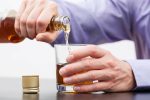During oral administration of ARI at doses 1, and 3 mg/kg on 4% alcohol intake, ARI did not reduce alcohol intake substantially (13 and 28%, respectively). Striatal D2R occupancy and brain exposure of ARI were considerably higher in CASA rats when compared to normal rats, suggesting that ARI could be a potential medication to treat the patients dually diagnosed with alcohol abuse and psychotic disorders (Nirogi et al., How to Stop Sneezing: 10 Natural Remedies 2013). Recent studies have suggested that ghrelin modulates signaling of dopaminergic neurons. Preclinical studies also provided support for an important role of ghrelin in the neurobiology of addiction-related reward pathways, affecting the self-administration of alcohol and drugs. Intermittent access to a nutritionally complete high fat diet attenuates alcohol drinking in Long Evans rats (Sirohi et al., 2017).
Prazosin may normalize these stress system adaptations, reduce alcohol craving, and reduce overall alcohol intake. We now focus on the novel medications and their signaling mechanisms by which they exert their effects on AUDs. These novel medications were developed to minimize the alcohol induced side effects https://accountingcoaching.online/transactional-writing-letters-that-heal/ and improve the quality of life. These groups of medications include novel as well as FDA-approved medications that are being repurposed for the prevention and treatment of AUDs. In some studies, the combination of these drugs was reported to exhibit potent effects than when they are used alone.
Medication for Alcohol Withdrawal
It works by normalizing alcohol related changes in the brain, reducing some of the extended physical distress and emotional discomfort people can experience when they quit drinking (also known as post-acute withdrawal syndrome) that can lead to relapse. Memantine, a non-competitive antagonist of NMDA receptors, (25 mg/kg) abolished ethanol self-administration in non-dependent (ND) rats and reduced self-administration by half in post-dependent (PD) rats during acute withdrawal. While this effect was observed only 6 hours after treatment in ND rats, it was long lasting in PD rats (at least 30 hours after injection). Furthermore, the results indicated that memantine did not modify the break-point for ethanol, suggesting that memantine acts by potentiating the pharmacological effect of ethanol but not by reducing the motivation for ethanol. Memantine was also ineffective in reducing relapse after protracted abstinence and may be used as a replacement therapy drug, but not as relapse-preventing drug (Alaux-Cantin et al., 2015).

Shortly thereafter, the FDA approved disulfiram to treat alcoholism. It was first manufactured by Wyeth-Ayerst Laboratories under the brand name Antabuse. Disulfiram was first developed in the 1920s for use in manufacturing processes. The alcohol-aversive effects of Antabuse were first recorded in the 1930s. Workers in the vulcanized rubber industry who were exposed to tetraethylthiuram disulfide became ill after drinking alcohol.
d. Other Medications
People who are experiencing difficulties with alcohol use should seek professional help. If someone cannot control their drinking habits or experiences negative consequences as a result of drinking, they may have AUD. Drugs used for other conditions — like smoking, pain, or epilepsy — also may help with alcohol use disorder.
Previously, Mason et al, have shown that treatment with nalmefene was effective in preventing relapse to heavy drinking in comparison to placebo. In a double-blind placebo-controlled trial, patients were given two doses of oral nalmefene (20- or 80-mg/day for 12 weeks) for alcohol dependence. Placebo treated patients showed significant relapse to heavy drinking (2.4 times greater) in comparison to nalmefene treated subjects (Mason et al., 1999). Martinotti et al, studied in a randomized double-blind comparison trial the effects of pregabalin and naltrexone by recruiting seventy-one patients and investigated the alcohol drinking indices (alcohol craving and relapse prevention) and psychiatric symptoms. Detoxified patients were randomized into two groups that received either pregabalin (150–450mg) and naltrexone (50mg) for 16 weeks. The results showed the pregabalin effects are similar to naltrexone in improving alcohol drinking indices, relapse rate and craving scores.
Medications for alcoholism: Medication list, benefits, risks, and more
If an alcohol use disorder or other compulsive drinking behavior is a factor in the development of gastritis, it can be especially challenging for the person to stop drinking in order to provide the best chance for helping this condition. In these cases, professional substance use rehabilitation could prove vital in helping the person begin to recover. Comprehensive, individualized alcohol treatment interventions can help individuals stop drinking alcohol and stay abstinent, minimizing the likelihood of relapse. In the recent Yale study reported in November 2020, researchers completed a double-blind study of 100 people entering outpatient treatment after being diagnosed with AUD. Researchers gave the drug to all patients who had experienced withdrawal symptoms before entering treatment. They found that subjects with high levels of shakes, cravings, anxiety, and sleep difficulties got the most from Prazosin.
- 32 males suffering from alcohol dependence were enrolled in a pilot study.
- Medications for substance use disorders are administered, dispensed, and prescribed in various settings such as a SAMHSA-accredited and certified opioid treatment program (OTP) or practitioners’ offices depending on the medication.
- The FDA lists the following possible side effects for medicines to treat alcohol dependence and alcohol use disorder.
- They may also benefit from attending support groups where they can share their experiences with others in recovery.
- It is generally used for the treatment of nausea and vomiting during chemotherapy and radiation therapy in many cancer patients.
- This is of particular concern when you’re taking certain medications that also depress the brain’s function.
